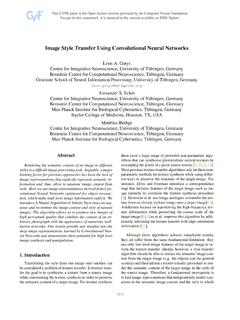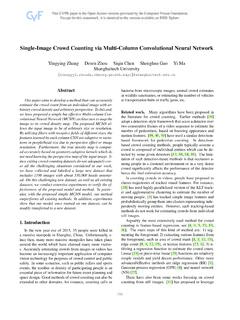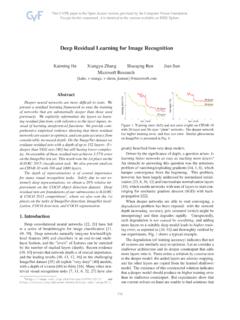Transcription of Deep Convolutional Neural Fields for Depth Estimation From ...
1 Deep Convolutional Neural Fields for Depth Estimation from a Single ImageFayao Liu, Chunhua Shen, Guosheng LinUniversity of Adelaide, Australia; Australian Centre for Robotic VisionAbstractWe consider the problem of Depth Estimation from a sin-gle monocular image in this work. It is a challenging taskas no reliable Depth cues are available, , stereo corre-spondences, motionsetc. Previous efforts have been focus-ing on exploiting geometric priors or additional sources ofinformation, with all using hand-crafted features. Recently,there is mounting evidence that features from deep convo-lutional Neural networks (CNN) are setting new records forvarious vision applications. On the other hand, consideringthe continuous characteristic of the Depth values, Depth esti-mations can be naturally formulated into a continuous con-ditional random field (CRF) learning problem. Therefore,we in this paper present a deep Convolutional Neural fieldmodel for estimating depths from a single image, aiming tojointly explore the capacity of deep CNN and continuousCRF.
2 Specifically, we propose a deep structured learningscheme which learns the unary and pairwise potentials ofcontinuous CRF in a unified deep CNN proposed method can be used for Depth estimationsof general scenes with no geometric priors nor any extra in-formation injected. In our case, the integral of the partitionfunction can be analytically calculated, thus we can exactlysolve the log-likelihood optimization. Moreover, solving theMAP problem for predicting depths of a new image is highlyefficient as closed-form solutions exist. We experimentallydemonstrate that the proposed method outperforms state-of-the-art Depth Estimation methods on both indoor and out-door scene IntroductionEstimating depths from a single monocular image de-picting general scenes is a fundamental problem in com-puter vision, which has found wide applications in scene un-derstanding, 3D modelling, robotics,etc.
3 It is a notoriouslyill-posed problem, as one captured image may correspondto numerous real world scenes [1]. Whereas for humans,inferring the underlying 3D structure from a single image isof little difficulties, it remains a challenging task for com-puter vision algorithms as no reliable cues can be exploited,such as temporal information, stereo correspondences, works mainly focus on enforcing geometric as-sumptions, , box models, to infer the spatial layout ofa room [2,3] or outdoor scenes [4]. These models comewith innate restrictions, which are limitations to model onlyparticular scene structures and therefore not applicable forgeneral scene Depth estimations. Later on, non-parametricmethods [5] are explored, which consists of candidate im-ages retrieval, scene alignment and then Depth infer usingoptimizations with smoothness constraints. This is basedon the assumption that scenes with semantic similar appear-ances should have similar Depth distributions when denselyaligned.
4 However, this method is prone to propagate errorsthrough the different decoupled stages and relies heavilyon building a reasonable sized image database to performthe candidates retrieval. In recent years, efforts have beenmade towards incorporating additional sources of informa-tion, , user annotations [6], semantic labellings [7,8].In the recent work of [8], Ladickyet al. have shown thatjointly performing Depth Estimation and semantic labellingcan benefit each other. Nevertheless, all these methods usehand-crafted from the previous efforts, we propose to formu-late the Depth Estimation as a deep continuous CRF learningproblem, without relying on any geometric priors nor anyextra information. Conditional Random Fields (CRF) [9]are popular graphical models used for structured predic-tion. While extensively studied in classification (discrete)domains, CRF has been less explored for regression (contin-uous) problems.
5 One of the pioneering work on continuousCRF can be attributed to [10], in which it was proposed forglobal ranking in document retrieval. Under certain con-straints, they can directly solve the maximum likelihoodoptimization as the partition function can be analyticallycalculated. Since then, continuous CRF has been appliedfor solving various structured regression problems, , re-mote sensing [11,12], image denoising [12]. Motivated byall these successes, we here propose to use it for Depth esti-mation, given the continuous nature of the Depth values, andlearn the potential functions in a deep Convolutional neuralnetwork (CNN).Recent years have witnessed the prosperity of deep con-volutional Neural networks (CNN). CNN features have beensetting new records for a wide variety of vision applica-tions [13]. Despite all the successes in classification prob-lems, deep CNN has been less explored for structured learn-ing problems, , joint training of a deep CNN and a graph-ical model, which is a relatively new and not well addressedproblem.
6 To our knowledge, no such model has been suc-cessfully used for Depth estimations. We here bridge thisgap by jointly exploring CNN and continuous sum up, we highlight the main contributions of thiswork as follows: We propose a deep Convolutional Neural field model fordepth estimations by exploring CNN and continuousCRF. Given the continuous nature of the Depth values,the partition function in the probability density func-tion can be analytically calculated, therefore we candirectly solve the log-likelihood optimization withoutany approximations. The gradients can be exactly cal-culated in the back propagation training. Moreover,solving the MAP problem for predicting the Depth ofa new image is highly efficient since closed form solu-tions exist. We jointly learn the unary and pairwise potentials ofthe CRF in a unified deep CNN framework, which istrained using back propagation.
7 We demonstrate that the proposed method outperformsstate-of-the-art results of Depth Estimation on both in-door and outdoor scene Related workPrior works [7,14,15] typically formulate the Depth es-timation as a Markov Random Field (MRF) learning prob-lem. As exact MRF learning and inference are intractablein general, most of these approaches employ approximationmethods, , multi-conditional learning (MCL), particlebelief propagation (PBP). Predicting the depths of a newimage is inefficient, taking around 4-5s in [15] and evenlonger (30s) in [7]. Furthermore, these methods suffer fromlacking of flexibility in that [14,15] rely on horizontal align-ment of images and [7] requires the semantic labellings ofthe training data available beforehand. More recently, Liuet al. [16] propose a discrete-continuous CRF model to takeinto consideration the relations between adjacent superpix-els, , occlusions.
8 They also need to use approximationmethods for learning and MAP inference. Besides, theirmethod relies on image retrievals to obtain a reasonableinitialization. By contrast, we here present a deep contin-uous CRF model in which we can directly solve the log-likelihood optimization without any approximations as thepartition function can be analytically calculated. Predictingthe Depth of a new image is highly efficient since a closedform solution exists. Moreover, our model does not injectany geometric priors or any extra the other hand, previous methods [5,7,8,15,16] alluse hand-crafted features in their work, , texton, GIST,SIFT, PHOG, object bank,etc. In contrast, we learn deepCNN for constructing unary and pairwise potentials of jointly exploring the capacity of CNN and continuousCRF, our method outperforms state-of-the-art methods onboth indoor and outdoor scene Depth estimations.
9 Perhapsthe most related work is the recent work of [1], which isconcurrent to our work here. They train two CNNs for depthmap prediction from a single image. However, our methoddiffers critically from theirs: they directly regress the depthmap from an input image through convolutions; in contrastwe use a CRF to explicitly model the relations of neigh-boring superpixels, and learn the potentials (both unary andpairwise) in a unified CNN framework. Moreover, the pre-dicted Depth map of [1] is 1/4-resolution of the original in-put image with some border areas lost, while our methoddoes not have this the most recent work of [17], Tompsonet al. present ahybrid architecture for jointly training a deep CNN and anMRF for human pose Estimation . They first train a unaryterm and a spatial model separately, then jointly learn themas a fine tuning step. During fine tuning of the wholemodel, they simply remove the partition function in thelikelihood to have a loose approximation.
10 In contrast, ourmodel performs continuous variables prediction. We candirectly solve the log-likelihood optimization without us-ing approximations as the partition function is integrableand can be analytically calculated. Moreover, during pre-diction, we have a closed-form solution for the MAP in-ference. Although no convolutions are involved, the workof [18] shares similarity with ours in that both use neuralnetworks to model the potentials of continuous CRF. Notethat the model in [18] only consists of one (fully connected)hidden layer, while ours uses deep CNNs. It is unclear howthe method of [18] performs on the challenging Depth esti-mation problem that we consider Deep Convolutional Neural fieldsWe present the details of our deep Convolutional neuralfield model for Depth Estimation in this section. Unless oth-erwise stated, we use boldfaced uppercase and lowercaseletters to denote matrices and column vectors OverviewThe goal here is to infer the Depth of each pixel in asingle image depicting general scenes.










![arXiv:1511.06434v2 [cs.LG] 7 Jan 2016](/cache/preview/a/6/2/2/c/1/b/6/thumb-a622c1b64bfa928610d6a5fe14bb4f33.jpg)